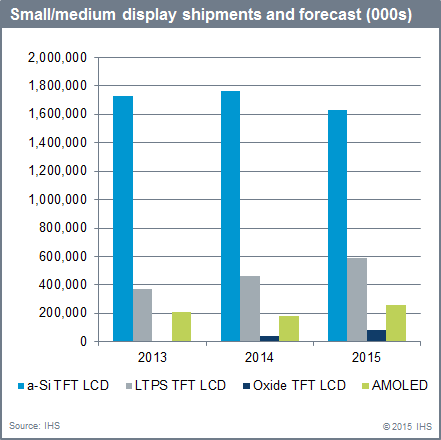Ongoing improvements in smartphone display performance is leading to increasing demand for high-resolution panels with lower power consumption requirements, which are not supported by the most common legacy technologies (non-crystalline thin-film silicon or a-Si for short).
According to IHS Inc. (NYSE: IHS),, the leading global source of critical information and insight, overall global shipments of small/medium (nine inches or smaller) a-Si TFT panels are forecast to decline 7 percent Y/Y in 2015, to reach 1.6 billion units. At the same time, shipments of newer LTPS TFT LCD and oxide TFT LCD panels, combined, will grow 33 percent to reach 676 million units, while AMOLED panel production will increase 44 percent to reach 260 million units.
“Multi-function smartphone panels will continue to dominate the small/medium display market this year, leading to a growing shift from a-Si TFT LCD to LTPS/oxide TFT LCD and AMOLED panels,” said Hiroshi Hayase, senior director for displays at IHS Technology. “This trend is expected to accelerate LTPS TFT investment and AMOLED panel production starting in 2016, which could affect the future survival of a-Si TFT suppliers.”
Based on the latest information from the IHS Technology Quarterly Small/Medium Shipment and Forecast Report, across all applications and size categories, a-Si TFT LCD technology continues to lead growth in the flat panel display (FPD) industry. However, the rise in smartphones has caused eroding demand for simple function applications using a-Si TFT displays such as feature phones, digital still cameras, portable games and other devices. “The smartphone performance revolution requires much higher resolutions and lower power consumption, which at this time can only be supported by LTPS TFT LCD, oxide TFT LCD and AMOLED technologies,” Hayase said.


